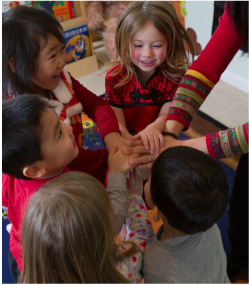Positive Behavior Guidance

A&D Stars seeks to promote positive behavior using age appropriate methods which focus on prevention, redirection, modeling, reflection and problem solving. Young children have not yet mastered the complex life skills of expressing strong emotions, resolving social problems, or getting along with others. We believe that Early Childhood Educators must lovingly guide children, help them learn to cooperate with their peers and teach them how to solve problems andmanage conflicts in peaceful and productive ways.
Our behavior guidance policy begins with prevention. We carefully arrange the physical aspects of the classroom (e.g. spatial arrangement) to help children interact appropriately. Our teachers are careful and attentive observers and are prepared to help redirect children to other areas/activities when undesirable behavior is imminent or occurs. For the youngest children who are not yet using language, redirection to activities that hold the child’s attention (the choice is made with the child) is the most often used method.
At the beginning of the school year, children are involved in the process of creating clear and reasonable class-made rules and expectations. This participation will help ensure their willingness to follow the rules and help develop self-control. Our teachers also model positive behavior for children and show them how to treat other people, how to deal with feelings, and how to approach problems. Positive reinforcementis used to take children’s attention away from unacceptable behaviors to desired behaviors. Reinforcement will be given immediately following a behavior to increase the likelihood of the behavior occurring again.
Children are taught to use their language to describe the event and identify their feelings andencouraged to think of alternative solutions and the possible effects of such solutions. Through problem solving, children develop a sense of responsibility for their own actions, begin to understand the needs of others, and strengthen their own decision-making skills.
Our behavior guidance policy begins with prevention. We carefully arrange the physical aspects of the classroom (e.g. spatial arrangement) to help children interact appropriately. Our teachers are careful and attentive observers and are prepared to help redirect children to other areas/activities when undesirable behavior is imminent or occurs. For the youngest children who are not yet using language, redirection to activities that hold the child’s attention (the choice is made with the child) is the most often used method.
At the beginning of the school year, children are involved in the process of creating clear and reasonable class-made rules and expectations. This participation will help ensure their willingness to follow the rules and help develop self-control. Our teachers also model positive behavior for children and show them how to treat other people, how to deal with feelings, and how to approach problems. Positive reinforcementis used to take children’s attention away from unacceptable behaviors to desired behaviors. Reinforcement will be given immediately following a behavior to increase the likelihood of the behavior occurring again.
Children are taught to use their language to describe the event and identify their feelings andencouraged to think of alternative solutions and the possible effects of such solutions. Through problem solving, children develop a sense of responsibility for their own actions, begin to understand the needs of others, and strengthen their own decision-making skills.

When a child is frustrated or mad, teachers will engage the individual in conversation and actively listen to the feelings and thoughts, expresses empathy and validation of feelings. The sense of safety and security afforded by positive relationship with teachers will help children learn to regulate their own behavior.
The last step, if the event warrants, is gently holding the child until self-control is attained and a feeling of safety and calm returns. Physical restraint will not be used unless it is necessary to protect the health and safety of the child or others. Parents will be contacted to pick up the child if all else fails.
In short, at A&D Stars, no harsh or physical punishments are used. Children may not be made fun of or threatened in any way. We do not use harsh or abusive tones of voice with children. Food may not be withheld as punishment nor are children punished for accidents related to toileting.
A Word About “Time Out”
A&D Stars does not utilize “Time Out.” We believe that Time Out can be viewed by the child as punitive, threatening and humiliating when used in a group care setting. In order to achieve our goal of helping children learn self-control, our job is to walk and talk them through their conflicts and undesirable actions.
The last step, if the event warrants, is gently holding the child until self-control is attained and a feeling of safety and calm returns. Physical restraint will not be used unless it is necessary to protect the health and safety of the child or others. Parents will be contacted to pick up the child if all else fails.
In short, at A&D Stars, no harsh or physical punishments are used. Children may not be made fun of or threatened in any way. We do not use harsh or abusive tones of voice with children. Food may not be withheld as punishment nor are children punished for accidents related to toileting.
A Word About “Time Out”
A&D Stars does not utilize “Time Out.” We believe that Time Out can be viewed by the child as punitive, threatening and humiliating when used in a group care setting. In order to achieve our goal of helping children learn self-control, our job is to walk and talk them through their conflicts and undesirable actions.
